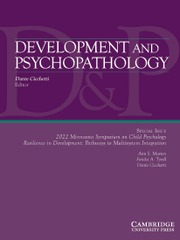Crossref Citations
This article has been cited by the following publications. This list is generated based on data provided by
Crossref.
Stormshak, Elizabeth A
and
Webster-Stratton, Carolyn
1999.
The Qualitative Interactions of Children With Conduct Problems and Their Peers.
Journal of Applied Developmental Psychology,
Vol. 20,
Issue. 2,
p.
295.
AUGUST, GERALD J.
REALMUTO, GEORGE M.
JOYCE, TAMARA
and
HEKTNER, JOEL M.
1999.
Persistence and Desistance of Oppositional Defiant Disorder in a Community Sample of Children With ADHD.
Journal of the American Academy of Child & Adolescent Psychiatry,
Vol. 38,
Issue. 10,
p.
1262.
Bellanti, Christine J.
and
Bierman, Karen L.
2000.
Disentangling the Impact of Low Cognitive Ability and Inattention on Social Behavior and Peer Relationships.
Journal of Clinical Child Psychology,
Vol. 29,
Issue. 1,
p.
66.
Stormshak, Elizabeth A.
Bierman, Karen L.
McMahon, Robert J.
and
Lengua, Liliana J.
2000.
Parenting Practices and Child Disruptive Behavior Problems in Early Elementary School.
Journal of Clinical Child Psychology,
Vol. 29,
Issue. 1,
p.
17.
Trautmann-Villalba, P.
Gerhold, M.
Polowczyk, M.
Dinter-Jörg, M.
Laucht, M.
Esser, G.
and
Schmidt, M.H.
2001.
Mutter-Kind-Interaktion und externalisierende Störungen bei Kindern im Grundschulalter.
Zeitschrift für Kinder- und Jugendpsychiatrie und Psychotherapie,
Vol. 29,
Issue. 4,
p.
263.
Harvey, Robin J
Fletcher, Janet
and
French, Davina J
2001.
Social reasoning.
Clinical Psychology Review,
Vol. 21,
Issue. 3,
p.
447.
Farmer, Alvin D.
Bierman, Karen L.
and
The Conduct Problems Prevention Res
2002.
Predictors and Consequences of Aggressive-Withdrawn Problem Profiles in Early Grade School.
Journal of Clinical Child & Adolescent Psychology,
Vol. 31,
Issue. 3,
p.
299.
Waschbusch, Daniel A.
2002.
A meta-analytic examination of comorbid hyperactive-impulsive-attention problems and conduct problems..
Psychological Bulletin,
Vol. 128,
Issue. 1,
p.
118.
Bierman, Karen
2002.
Predictor Variables Associated with Positive Fast Track Outcomes at the End of Third Grade.
Journal of Abnormal Child Psychology,
Vol. 30,
Issue. 1,
p.
37.
van Lier, Pol A.C.
Verhulst, Frank C.
van der Ende, Jan
and
Crijnen, Alfons A.M.
2003.
Classes of disruptive behaviour in a sample of young elementary school children.
Journal of Child Psychology and Psychiatry,
Vol. 44,
Issue. 3,
p.
377.
Miller, Alison L.
Kiely Gouley, Kathleen
Seifer, Ronald
Dickstein, Susan
and
Shields, Ann
2004.
Emotions and Behaviors in the Head Start Classroom: Associations Among Observed Dysregulation, Social Competence, and Preschool Adjustment.
Early Education & Development,
Vol. 15,
Issue. 2,
p.
147.
Miller, Jeffrey A.
Williams, Shelagh J.
and
McCoy, Erika L.B.
2004.
Using multimodal functional behavioral assessment to inform treatment selection for children with either emotional disturbance or social maladjustment.
Psychology in the Schools,
Vol. 41,
Issue. 8,
p.
867.
Graber, Julia A.
Brooks-Gunn, Jeanne
and
Archibald, Andrea B.
2005.
Developmental Psychobiology of Aggression.
p.
87.
McCarty, Carolyn A.
and
McMahon, Robert J.
2005.
Domains of risk in the developmental continuity of fire setting.
Behavior Therapy,
Vol. 36,
Issue. 2,
p.
185.
Wakschlag, Lauren S.
Leventhal, Bennett L.
Briggs-Gowan, Margaret J.
Danis, Barbara
Keenan, Kate
Hill, Carri
Egger, Helen L.
Cicchetti, Domenic
and
Carter, Alice S.
2005.
Defining the “Disruptive” in Preschool Behavior: What Diagnostic Observation Can Teach Us.
Clinical Child and Family Psychology Review,
Vol. 8,
Issue. 3,
p.
183.
Fraser, Mark W.
Galinsky, Maeda J.
Smokowski, Paul R.
Day, Steven H.
Terzian, Mary A.
Rose, Roderick A.
and
Guo, Shenyang
2005.
Social Information-Processing Skills Training to Promote Social Competence and Prevent Aggressive Behavior in the Third Grades..
Journal of Consulting and Clinical Psychology,
Vol. 73,
Issue. 6,
p.
1045.
KELLER, THOMAS E.
SPIEKER, SUSAN J.
and
GILCHRIST, LEWAYNE
2005.
Patterns of risk and trajectories of preschool problem behaviors: A person-oriented analysis of attachment in context.
Development and Psychopathology,
Vol. 17,
Issue. 02,
Haberstick, Brett C.
Schmitz, Stephanie
Young, Susan E.
and
Hewitt, John K.
2005.
Contributions of Genes and Environments to Stability and Change in Externalizing and Internalizing Problems During Elementary and Middle School.
Behavior Genetics,
Vol. 35,
Issue. 4,
p.
381.
Trautmann-Villalba, Patricia
Gschwendt, Miriam
Schmidt, Martin H.
and
Laucht, Manfred
2006.
Father–infant interaction patterns as precursors of children’s later externalizing behavior problems.
European Archives of Psychiatry and Clinical Neuroscience,
Vol. 256,
Issue. 6,
p.
344.
Brook, Judith S.
Brook, David W.
Balka, Elinor B.
and
Rosenberg, Gary
2006.
Predictors of Rebellious Behavior in Childhood.
Journal of Addictive Diseases,
Vol. 25,
Issue. 2,
p.
77.

